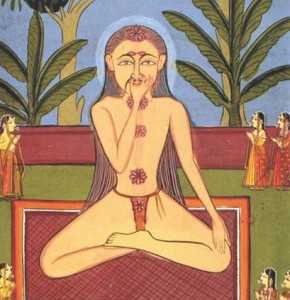

Kapalabhati
«Kapalabhati» literally means light, brilliance, shine («Bhati») of the skull («Kapala») or «Skull Illumination». In Yoga and Ayurveda, «Kapalabhati» refers to a breathing exercise from the «Pranayama» with a rapid sequence of strong exhalations and automatic inhalations. «Kapalabhati» belongs to the «Six Shatkriyas». «Kapalabhati» is one of the most popular and effective breathing exercises («Pranayama») in Yoga.
On a physical level, «Kapalabhati» frees the sinuses and helps to reduce «Kapha» (mucus). On an energetic level, «Kapalabhati» activates «Prana», on a mental level it helps to clear the mind.
Table of Contents
1 Sukadev about Kapalabhati
2 Execution of Kapalabhati
3 Kapalabhati — Description by Swami Sivananda
4 Kapalabhati — Cleansing of Breath, Mind and Body
5 Kapalabhati Variations
5.1 Soft Kapalabhati
5.2 Medium Intensive Kapalabhati
5.3 Intensive Kapalabhati — also: Vata Kapalabhati
5.4 Kapalabhati according to Different Speed
5.4.1 Slow Kapalabhati
5.4.2 Medium Speed Kapalabhati
5.4.3 Fast Kapalabhati
5.4.4 Very Fast Kapalabhati1.
5.5 Kapalabhati according to Different Aims and Orientations
5.5.1 Reciprocal Kapalabhati
5.5.2 Kapha Kapalabhati
5.5.3 Chandra Kapalabhati
5.5.4 Surya Kapalabhati
5.5.5 Plavini Kapalabhati
5.5.6 Ujjayi Kapalabhati
5.5.7 Unilateral and Reciprocal Kapalabhati with Bahir Kumbhaka
6.1 Video — Pranayama for a Blocked Nose
7.1 Physical
7.2 Energetic
7.3 Mental
7.4 Ayurveda Dosha Effect
Sukadev about Kapalabhati
Transcription of a Podcast from Sukadev.
«Kapalabhati» is the first Breathing Exercise in the Yoga Vidya series, the first «Pranayama». You can practice «Kapalabhati» in a whole Yoga Lesson. But you can also practice «Kapalabhati» separately. You can practice «Kapalabhati» both sitting and standing. «Kapalabhati» activates your «Prana», the life energy. «Kapalabhati» brings new oxygen to your brain and let you inside radiant, makes you feel light. «Kapala» means skull, «Bhati» means radiance. If you want to learn «Kapalabhati», you typically practice sitting first.
You're first just sitting down for that. You put one hand on your belly and while you breathe in, your belly goes outward. While you breathe out, the belly goes inward. Breathe in for 3-4 seconds, the belly goes outward, breathe out for 3-4 seconds, the belly goes inward. Breathe a few times like this. The actual «Kapalabhati» will be that you exhale quickly and inhale gently. It's like you're blowing a piece of paper away through your nose. Now breathe out, breathe in and start.
Breathe out completely, breathe in very deeply, completely, breathe out again completely, then breathe in comfortably and hold your breath. Concentrate you on the belly, you may feel warmth there. Maybe you can also imagine that energy rises up from the belly over the chest to the head or up through the spine. Feel you invigorated and full of power. Whenever helpful, breathe normally again.
Before I lead the next round, be aware once again that with «Kapalabhati» you breathe out quickly and in gently. While you exhale your belly goes inward, while you inhale your belly goes forward. And only the exhalation is firm and conscious, the inhalation goes all by itself and you hear the breath when you exhale, and thereby the belly goes inward. You can also check this by placing your hand on the umbilical region. While you exhale, the belly goes inward, while you inhale, the belly goes forward. Once again, exhale, belly goes inward, inhale, belly goes forward and start.
Breathe out completely, breathe in, bring the belly forward, breathe out completely, bring the belly inward. Breathe in, belly comes forward, and hold your breath. The spine is straight, feel how the abdomen is warm, feel energy rising from the abdomen to the chest, to the neck, to the head or feel how the energy rising through the spine. Feel you revitalized, full of energy, full of «Prana», full of life energy. Whenever necessary, continue to breathe normally and feel continually the vitality pulsating in your body. One round more.
Breathe in very deeply and out completely, breathe in, belly forward, breathe out, belly inward, breathe in, belly outward and start. Breathe out completely, breathe in deeply, new light, new strength, new positivity, breathe out completely, breathe in, fill the lungs to about 2/3 and then hold the breath. Now concentrate you on the forehead and the region of the vertex. Maybe you feel a light there, maybe you feel a radiance there. «Kapalabhati» means «Radiant Head». Feel this radiance and this lightness.
Exhale slowly and completely. Then continue breathing normally a few times and feel this feeling of energy, of power, of pulsation. Especially if you have an excess of «Kapha», frequent «Kapalabhati» is quite good. You can also practice «Kapalabhati» lying in bed, just breathe in and out quickly a few times while lying down. You can quickly inhale and exhale a few times whenever you need new strength. Especially «Kapha Types» then get going quickly.
By the way, if you have too much «Vata», you should not practice «Kapalabhati» too much and a «Man with Pitta» should practice «Kapalabhati» moderately, but especially for someone with a lot of «Kapha» and just when the «Kapha» becomes inertia, «Kapalabhati» gets to going. And you can practice it lying down, on the chair, sitting, in the car, wherever. You can also increase «Kapalabhati» up to 100 or even 200 exhalations. Feel if it does you good. If it is good for you, practice it. Practice it especially to get new strength and inspiration.
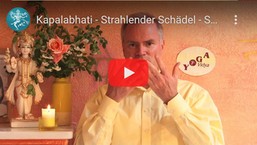
 |
 |
Execution of Kapalabhati
«Kapalabhati» consists of two parts:
➳The rapid inhalation and exhalation. Thereby the inhalation is about twice as slow as the exhalation. The exhalation is active. The inhalation is passive, that means it happens by itself through relaxation. In the beginning, breathe in 20-30 times, later on it can be increased up to 200 (or even more).
➳Holding the breath («Kumbhaka»): In «Kapalabhati» one holds the breath as long as it is comfortable. Thereby the lungs are filled to about 75%, so very comfortable. The holding of the breath should not be forced.
Between the fast breaths and the holding 0-2 intermediate breaths can be made.
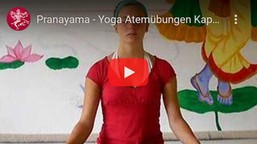
 |
 |
Kapalabhati — Description by Swami Sivananda
This exercise prepares the student for the practice of Bhastrika Pranayama. It is one of the purification exercises known in Hatha Yoga as Shatkriyas, «the six actions». Those who are practiced in «Kapalabhati» can perform the Bhastrika with ease.
Sit in the «Padmasana» (or other cross-legged sitting posture). Let your hands rest on your knees (or thighs). In quick succession, perform Puraka and Rechaka as if you were operating the bellows of a blacksmith. This is called «Kapalabhati». Perform the exercise dynamically. You will work up a good sweat. There is no holding of breath («Kumbhaka») in this exercise. Rechaka plays an important role here. Strong exhalations follow each other quickly.
This exercise has a tremendous effect; when you do it, all the tissues, cells, nerves, tendons, and molecules will vibrate powerfully.
At the beginning start with a speed of one exhalation per second. Then step by step increase the speed to two exhalations per second. Start with a round of «Kapalabhati»in the morning with only ten exhalations. In the second week, do one round in the morning and one in the evening, in the third week two rounds in the morning and two in the evening, in the fourth week three rounds in the morning and three in the evening. At the end of each round, take a short break and let the breath flow in and out normally. This will help you to relax well. Later, when you have mastered the technique well, you can add ten more exhalations to each round until you reach 120 exhalations per round.
The exercise of «Kapalabhati» cleanses the skull, the respiratory organs and the airways. It combats diseases caused by inertia. It eliminates bronchial spasms and therefore relieves and cures asthmatic conditions.
The tips of the lungs are supplied with oxygen in abundance and therefore do not form a favorable breeding ground for tubercle bacilli (TB); therefore consumption is cured by this exercise. The lungs are strongly developed; carbon dioxide is excreted in large quantities. The blood is cleaned; impurities in the blood are excreted. Tissues and cells absorb a large amount of oxygen. The heart functions as it should. Circulation, respiratory and digestive systems are strengthened to a great extent.
Kapalabhati — Cleansing of Breath, Mind and Body
Article by Swami Saradananda: The Sanskrit word «Kapala» means skull; «Bhati» means shining. In this exercise you use your breath to cleanse your respiratory and circulatory system. Through regular practice, «Kapalabhati» thoroughly refreshes your whole organism so that your face radiates with good health from within.
The best time to practice «Kapalabhati» is right after the «Neti Practice» at the beginning of your «Pranayama Practice» or before the Meditation.
«Kapalabhati» cleans your nasal passages, lungs and the entire respiratory system, strengthens the lungs and increases lung capacity. It contributes to the drainage of your sinuses and helps to prevent the accumulation of mucus. At the same time, «Kapalabhati» removes carbon dioxide and other impurities from your bloodstream and allows red blood cells to connect better with oxygen. The extra oxygen enriches your blood and helps renew body tissues.
The movement of your diaphragm and the contractions of your abdominal muscles massage your stomach, liver, spleen, heart and pancreas. Your abdominal muscles become stronger; your digestion improves.
«Kapalabhati» refreshes and invigorates your mind. You will most likely experience a state of heightened alertness as a result of the additional intake of fresh air. Through «Kapalabhati» you can put yourself in high spirits and your mental clarity will increase.
Kapalabhati Practice: Sit down, preferably cross-legged. Keep your back and head straight. If you cannot sit with your legs crossed, sit on a chair and put your feet on the floor. Take 2-3 deep breaths in and out, then inhale again and start with rhythmic abdominal pumping movements:
- Contract your abdominal muscles quickly. As a result, your diaphragm will move up to your chest cavity, empty your lungs and expel air through your nostrils.
- Relax your abdominal muscles; passive inhalation takes place. Your lungs are automatically filled with air. Do not use force to take a breath.
Repeat this quick pumping. Finish exhaling and then take 2-3 more deep breaths to return to your normal breathing rhythm. This is a round of «Kapalabhati».
Start with three rounds of 20-25 pumping movements each. Develop your daily practice step by step in 3-5 rounds of 30-50 pump movements.
Caution: «Kapalabhati» should be practiced gently during pregnancy without holding your breath or only holding for a short time. It is contraindicated in hernia (diaphragmatic hernia).
The mechanisms of «Kapalabhati» are difficult to understand. It is recommended to learn them from an experienced qualified Yoga teacher.
Kapalabhati Variations
At first the Yoga practitioner should practice «Kapalabhati» in its basic form. To bring some variety into the practice and to increase the effect, there are different «Kapalabhati Variations». Sometimes, however, the basic exercise of «Kapalabhati» is most effective.
Kapalabhati according to different intensity
Soft Kapalabhati
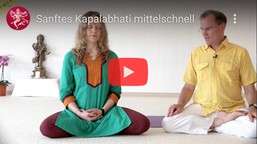
 |
 |
Medium Intensive Kapalabhati
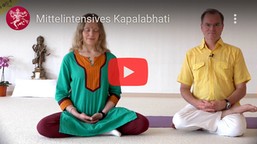
 |
 |
Intensive Kapalabhati — also: Vata Kapalabhati
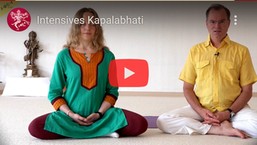
 |
 |
Kapalabhati according to Different Speed
Slow Kapalabhati
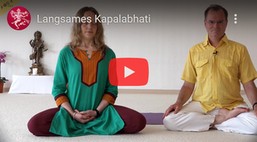
 |
 |
Medium Speed Kapalabhati
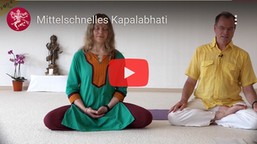
 |
 |
Fast Kapalabhati
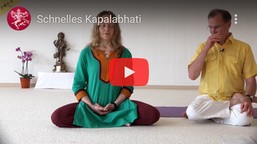
 |
 |
Very Fast Kapalabhati
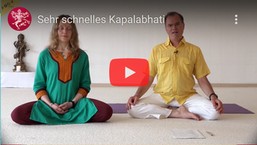
 |
 |
Kapalabhati according to Different Aims and Orientations
Reciprocal Kapalabhati
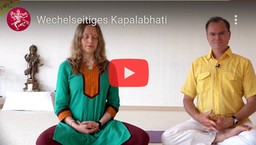
 |
 |
Kapha Kapalabhati
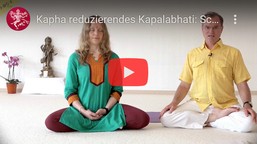
 |
 |
Chandra Kapalabhati
«Chandra Kapalabhati», a «Kapalabhati Variation», where you inhale and exhale all the time on the left side only. Suppose you want to increase your moon energy, you could practice «Chandra Kapalabhati». For example, you could practice «Chandra Kapalabhati» if you have a lot of «Pitta» from Ayurveda or if you want to strengthen your intuitive side a bit or practice «Kapalabhati» and with this you will find more access to intuition and sensitivity. First exhale very completely, inhale very deeply, exhale completely, now close the right nostril with your right thumb, inhale and start inhaling and exhaling with the left nostril only, start: «Out, in, out, in, out, in...». Continue like this and always keep your right thumb on your right nostril, so that you inhale and exhale the whole time on the left. Exhale completely on the left, inhale deeply and completely on the left, exhale again completely on the left.
Then breathe in comfortably on the left and hold your breath, now you can also lower your hand, either fold your hands, lay them on top of each other or place both hands on your thighs or knees. And imagine cooling energy flowing into you from above, cooling energy, inspiring energy. Feel you with this completely relaxed, in contact with this blessing, this light, this cooling, relaxing energy. Holding as long as it is pleasant and when the impulse to exhale comes, close the right nostril and then exhale on the left. Breathe out completely on the left and then you can lower your hand and continue breathing normally.
That was «Chandra Kapalabhati», literally «Moon Kapalabhati», whereby «Chandra» does not only mean moon, «Chandra» also means rays, also means shining, also means joy, also means love. One could say, «Chandra Kapalabhati» strengthens this energy of joy, love, letting go, relaxation and inspiration. Of course, there is also the «Surya Kapalabhati», for this there is another lecture, there is «Reciprocal Kapalabhati», for this there is also another lecture and many variations of «Kapalabhati on Both Sides».
Surya Kapalabhati
«Surya Kapalabhati» is a variation of «Kapalabhati» in which one inhales and exhales only through the right nostril. By inhaling and exhaling through the right nostril, the «Pingala Nadi», also called «Surya Nadi», is opened and thus the «Surya Energy», that means the solar energy, is strengthened.
Plavini Kapalabhati
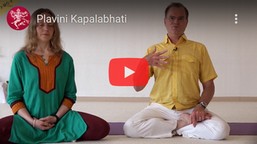
 |
 |
Ujjayi Kapalabhati
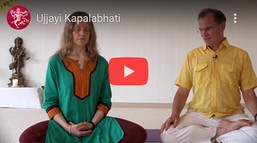
 |
 |
Unilateral and Reciprocal Kapalabhati with Bahir Kumbhaka
Sit down with your legs crossed. Important: Back straight, neck straight.
- First round: Close the right nostril. Breathe in and out quickly through left nostril. Then exhale the air completely. Support your hands in the «Chin-Mudra» (thumb and index finger touching) on your knees. Bend the upper body slightly forward from the hips. Keep your back straight, arms straightened if necessary. Hold your breath with empty lungs. Do «Mula-Bandha» and gentle «Uddhiyana-Bandha», possibly also «Jalandhara-Bandha». If you don't can holding, inhale again.
- Round 2: Like Round 1, but inhale and exhale only through the right nostril.
- Round 3: Like Round 1, but this time inhale and exhale through both nostrils.
Note: Between the 2nd and 3rd Round, you can also make a Round with alternating inhalation and exhalation.
Warning Without a previous and well-founded learning of the practices and exercises from a certified professional (for example a Yoga Teacher), the execution of these practices can lead to that the desired effect not occurring or even cause health damage! |
Practical Tips
Video — Pranayama for a Blocked Nose
With this video Sukadev shows you the trick with the little finger, so that you can practice «Kapalabhati» even with a blocked nose.
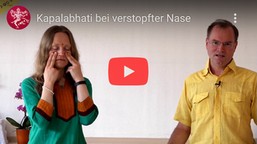
 |
 |
Effects of Kapalabhati
Physical
Strengthens the diaphragm and the respiratory muscles. Cleanses the lungs. Massages the heart, liver and stomach. During the period of rapid breathing, the oxygen content in the blood is greatly increased. The blood becomes alkaline (basic), which improves certain metabolic processes and purification. When the breath is holding, the level of carbon dioxide in the blood increases, which in turn stimulates other metabolic processes and improves lung efficiency. The time of holding the breath is a training stimulus, which leads to an increase the lung capacity and improves circulation and heart activity. «Kapalabhati» helps to clean the respiratory tract (bronchi, alveoli, windpipe and nasal passages) and is a good prevention against hay fever, asthma and colds. «Kapalabhati» has a cleansing and purifying effect on the whole body.
Energetic
«Kapalabhati» activates the solar plexus. The energy rises up to the head and radiates from there. «Kapalabhati» means «Shining Skull» and refers to the feeling of energy radiating from the head. By means of the «Mula-Bandha» (root closure = contraction of the pelvic floor muscles), visualization and concentration, one can direct the «Prana» into the «Sushumna» (subtle spine) and activate the Chakras.
Mental
«Kapalabhati» activates and helps to clear the mind. It is very good for removing mental and emotional tensions. It helps against tiredness and dejection and leads to an inner joy and strength.
Ayurveda Dosha Effect
According to the Hatha Yoga Pradipika, «Kapalabhati» reduces an excess of «Kapha Dosha».

